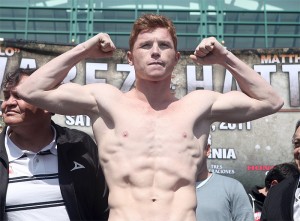
Marco Antonio Barrera has warned us about cases like Mexican Saul “Canelo” Alvarez. No, not by name – the way Juan Manuel Marquez just did – or by specific timeframe, either. Barrera’s warnings come only by implication: boxing was off Mexico’s public airwaves for most of the last decade, and that will have consequences.
Boxing is back on Mexico’s airwaves, and the pueblo’s appetite for our sport is voracious. Mexicans see more boxing these days than Americans do; all those European cards and American undercards you need a pirated link to see are broadcast on basic cable, there. To invert Sir John Falstaff’s advice, though, Mexicans are about to start calling some counterfeits true pieces of gold.
Is “Cinnamon” Alvarez a counterfeit? We don’t know yet, and at this rate we won’t know for a long time. We got only a little closer to the truth of this horse-mounting Jalisciense with red hair and freckles, Saturday, when he battered Matthew Hatton, a determined b-grade Brit with a famous brother, and won a unanimous decision by three scores of 119-108, on HBO.
Alvarez is not exactly what Barrera warned us about, but he may be in the vanguard of the movement. When most Mexicans without satellite dishes stopped seeing boxing with any sort of regularity, Alvarez was nine years old. In Mexico, as in every other place on Earth, the children of homeowners with satellite dishes do not populate boxing’s amateur ranks. How many young Mexicans of inauspicious beginnings did not take up the sport – for want of exposure – in the 11 years Alvarez was building himself from an ethnic anomaly to a ticket-selling attraction?
How much better, in other words, were the Mexican 15-year-olds against whom Barrera and Marquez learned their craft in the 1980s?
It’s a good question. Here is a better one. What did a decade away from routine examination of fighters do to Mexico’s national afición?
There is a reasonable assumption in Mexico that the best of their countrymen are the best prizefighters in the world. To come out of Mexico in the past, a prizefighter had to survive so many tests that his mettle could not be doubted. But for the next five to 10 years, the default assumption that steels Mexicans’ support of their fighters may well be disconnected from the reality of what tests their young fighters now pass.
Take that possibility and add to it Mexicans’ spring-loaded appetite for boxing, and you get a phenomenon like Canelomania, one that puts more than 10,000 fans in an arena to see a showcase bout.
But is Alvarez’s promoter Golden Boy Promotions really doing anything differently from what rival Top Rank did with Julio Cesar Chavez Jr.?
Yes, actually. Chavez Jr. was going to be a draw whether or not he could fight even a little bit. A Mexican form of self-deception was not needed to sell Chavez Jr.; the kid’s father was the only thing that went right in Mexico in the 1990s, and Mexicans are a proud, loyal people.
Alvarez is a supposedly organic discovery, on the other hand, from a place – Tlajomulco de Zúñiga, Jalisco – most Mexicans couldn’t pronounce any more easily than they could find it on a map. Alvarez is marketed as a true piece of gold; Oscar De La Hoya says he’s never seen a 20 year-old so very developed – and that means a lot to fight fans in Mexico who still think of De La Hoya as a fighter, not a promoter.
But was Alvarez the most-developed 20 year-old you’ve ever seen, Saturday? Of course not. He realized in the first five minutes that not one Hatton punch, lucky or otherwise, could hurt him. Then he spent the next half hour stalking Hatton, with his hands and chin lowered. He wacked away at Ricky’s brother with impunity and beat him pretty good. He never dropped him, though, and Hatton was still on his toes bouncing when the 12th round began.
Alvarez has no defense to speak of. He has strong legs, but he does not bob. His footwork is simple; it’s not wrong, by any means, but neither is it complicated. His hands stray low every time he loads a punch. His head stays between opponents’ shoulders.
None of this would be a problem, one supposes, if he had break-you-in-half power. He does not. His left hooks are wide and sometimes sloppy. His uppercuts are thrown well and authoritatively, but does he have hand-speed enough to land them against elite fighters?
If they were to fight next week, James Kirkland would tear Alvarez apart. Alfredo Angulo would wear him down. Paul Williams would outland him 30 to 1. Miguel Cotto would likely finish the job his brother started 10 months ago. And Julio Cesar Chavez Jr. would outbox him. No, that’s not a typo.
¡Cálmate, cabrón! Alvarez is only 20 years-old. How can you compare his chances to such beasts as those listed above?
Fair point. Alvarez needs more seasoning, some time in the minors to hone his skills. Who could argue?
Which raises one last question. Since when is HBO our sport’s minor-league affiliate?
Sometime in the last three years – that’s the answer, if you’re scoring at home. Saturday’s telecast was fine an example as any of what HBO has become: an Oscar De La Hoya-search company that populates its undercards with Al Haymon-managed trial balloons. That’s why it is now our sport’s number two network.
Alas, that’s someone else’s problem. But Alvarez and Chavez Jr. are our problem, as aficionados, because they represent Mexican prizefighting in the near term. Until they fight one another, we shouldn’t take either too seriously. Americans already know this. Mexican fans might need a reminder:
Hasta que pelean Canelo y Junior, hay que cuidar nuestro apoyo completo.
Bart Barry can be reached via Twitter: @bartbarry